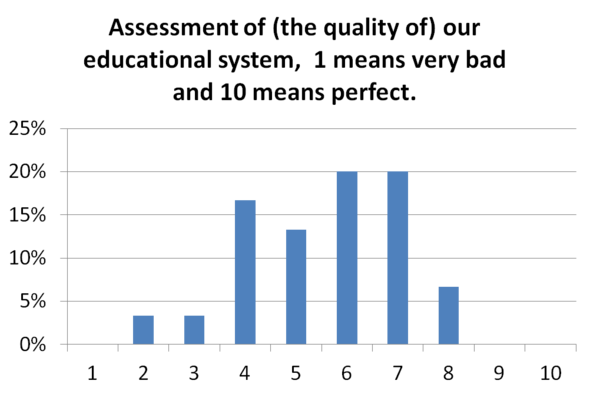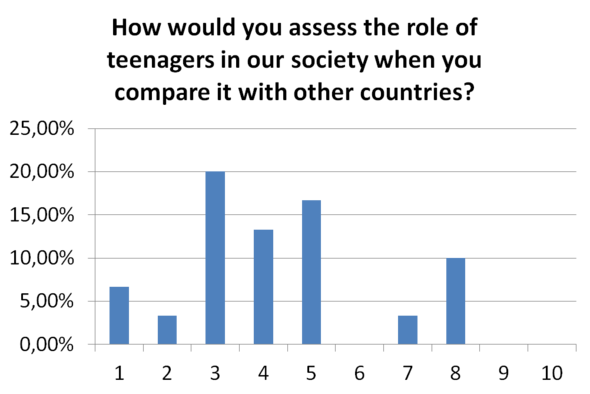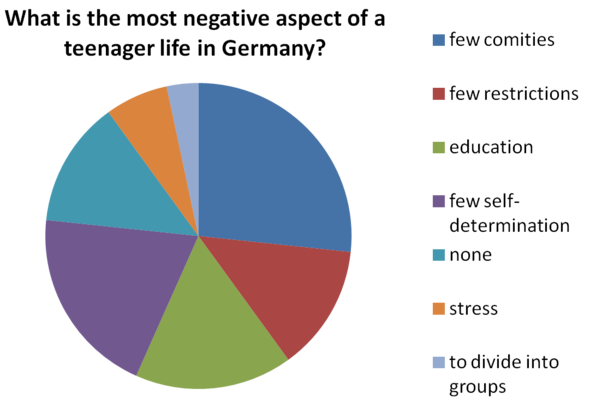Talking about charts - Diagramme beschreiben - Text korrigieren?!
Hallöchen Leute! Wir sollten am Montag eine Survey (Umfrage) vorberiten und diese sollen wir am Freitag präsentieren, nur bin ich nicht soooo gut in Englisch und weiß nun nicht ob mein Text richtig ist, oder ob ich noch irgendwas ergänzen oder verbessern könnte/ müsste/ sollte... Es wäre also echt total lieb von euch, wenn ihr mir dabei helfen könntet und ich wäre euch auch zutiefst dankbar dafür!!! Also schon mal ein Dankeschön im vorraus. Lg Cersia <3
Bewerten sie die Qualität unseres Bildungssystems von sehr schlecht (1) bis perfekt (10). - Assessment of (the quality of) our educational system, 1 means very bad and 10 means perfect.
Diagramm 1: The bar chart depicts ten options, which the students, on the invitation: “Assessment of (the quality of) our educational system?” could tick, where 1 means very bad and 10 means perfect. The options scale is on the horizontal axis and the percentage terms scale runs vertically. Only slightly more than 45% of the sample had answered that they guessed our educational system is a little more than the average, but it is not perfect. As opposed to this only a small fraction of the adolescences answered that our educational system is very bad.
Wie bewerten sie die Stellung der Jugendlichen in der Gesellschaft im Vergleich zu anderen Ländern? (1- besser als in anderen Ländern, 10- wir haben es am schlechtesten) - How would you assess the role of teenagers in our society when you compare it with other countries?
Diagramm 2: The diagram represents, whether the students assess the role of teenagers in our society, therefore shows that the majority of questioned adolescence be of the same opinion that the role of teenager in Germany are better than other countries. Significantly fewer students answered that the role of young people in Germany are not as good as in other countries.
Was ist für sie der negativste Aspekt am Teenager-Leben in Deutschland?- What is the most negative aspect of a teenager life in Germany?
Diagramm 3: The pie chart illustrates in percentage terms, what youngsters think is the most negative aspect of a teenager life in Germany. The pie chart depicts, that the section “few restrictions” had exactly the same percentage as the section “none”. The stages “few comities”, “few restrictions” and “education” combined are more than half. The answer “few self-determination” makes up for 20 %. This is in sharp contrast to the answer “stress” or “to divide into groups”, only 3 students had answered that one of this section is the most negative aspect of a teenager life in Germany.



2 Antworten
hoffentlich ist es einer hilfe.....schaue nach wo ich korrigiert habe, damit du etwas daraus lernst. :-))
Diagramm 1: The bar chart depicts ten options, which the students, on the invitation: “Assessment of (the quality of) our educational system?” could tick, where 1 means very bad and 10 means perfect. The options scale is on the horizontal axis and the percentage terms scale runs vertically. Only slightly more than 45% of the sample answered that they thought our educational system is a little better than the average, but it is not perfect. As opposed to this only a small fraction of the adolescents answered that our educational system is very bad.
Wie bewerten sie die Stellung der Jugendlichen in der Gesellschaft im Vergleich zu anderen Ländern? (1- besser als in anderen Ländern, 10- wir haben es am schlechtesten) - How would you assess the role of teenagers in our society when you compare it with other countries?
Diagramm 2: The diagram illustrates, how the students assessed the role of teenagers in our society, it shows that the majority of questioned adolescents are of the same opinion, that the role of teenagers in Germany is better than in other countries. Significantly fewer students answered that the role of young people in Germany is not as good as in other countries.
Was ist für sie der negativste Aspekt am Teenager-Leben in Deutschland?- What is the most negative aspect of a teenagers life in Germany?
Diagramm 3: The pie chart illustrates in percentage terms, what youngsters think is the most negative aspect of a teenagers life in Germany. The pie chart depicts, that the section “few restrictions” had exactly the same percentage as the section “none”. The stages “few comities”, “few restrictions” and “education” combined make up more than half. The answer “little self-determination” makes up for 20 %. This is in sharp contrast to the answer “stress” or “to divide into groups”, only 3 students answered that one of these sections is the most negative aspect of a teenagers life in Germany.
Da hast du aber Recht..... aber es gab null antworten (Wie du sehen kannst von den Uhrzeiten) und ich hatte ein paar minuten und tat das notwendigste mit was da war....manches war nicht mal verständlich...zB.comities und stages etc. aber ich hatte null zeit nachzufragen, und dachte alles ist besser als nix. Da es für ein präsentation war (mundliche vorführung), war mir kommasetzung etc. sehr zweiträngig. Der alternative war jemand mit kein antwort zu lassen....und daher habe ich das wesentliche auf die schnelle korrigiert
warum mache ich das hier,und mich gerechtfertigen???.....keine ahnung da gibt es sonst 1000er mist antworten und keiner fühlt sich schuldig.
Ich würde gar nicht das Wrot "diagram" - übrigens mit EINEM m - nehmen, sondern eben "chart".
KEIN Komma nach "options"
Was soll "invitation" heißen?
Kein Komma vor "on the invitation"
"answered" - nicht "had answered"
of the adolescents
Chart 2 shows how... (kein Komma!!!!)
Der Halbsatz mit "therefore" ergibt keinen Sinn.
role of teenagers
the role ... is (nicht "are) . Was soll "good" hier bedeuten?
Chart 3: KEIN Komma vor "what"!!! Das "is" im ersten Satz muss an den Schluss.
KEIN Komma vor "that" (nach depicts)
"stages" und "comities" verstehe ich leider nicht.
"answered" - nicht "had answered" - Die Syntax im Schluss-Satz stimmt irgendwie nicht.
one of these sections? Was ist gemeint?
Achte darauf: Die Kommaregeln im Englischen sind GANZ anders als im Deutschen. Insgesamt gibt es im Englischen viel weniger Kommata. Achte auch darauf, dass Du simple past - und nicht past perfect - verwnendest- außer natürlich bei echter VORZEITIGKEIT in der Vergangenheit.
Da hast Du aber EINIGES an Fehlern übersehen: Falsch gesetzte "deutsche" Kommata, teenager's life, diagram (besser: chart), ...
Was ist mit "stages" gemeint?